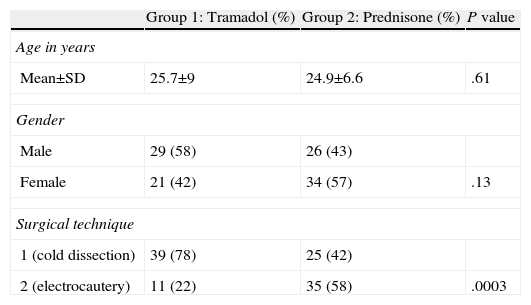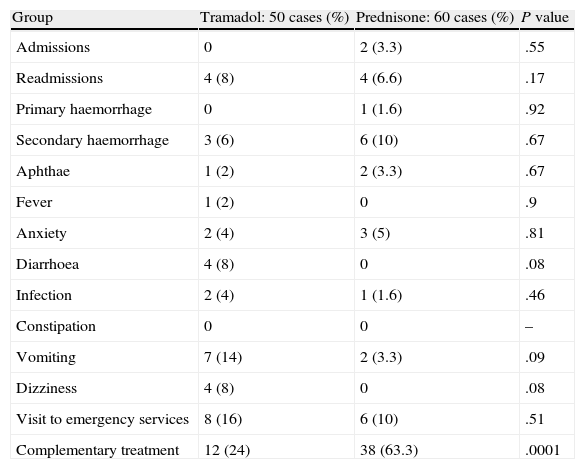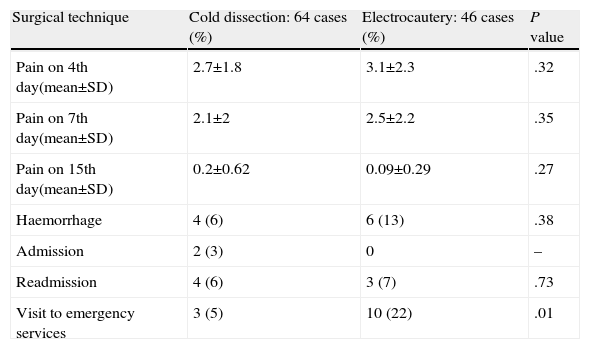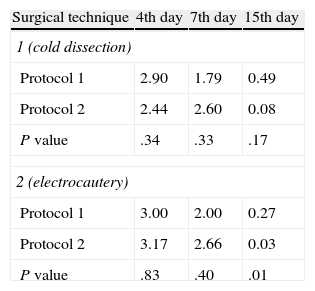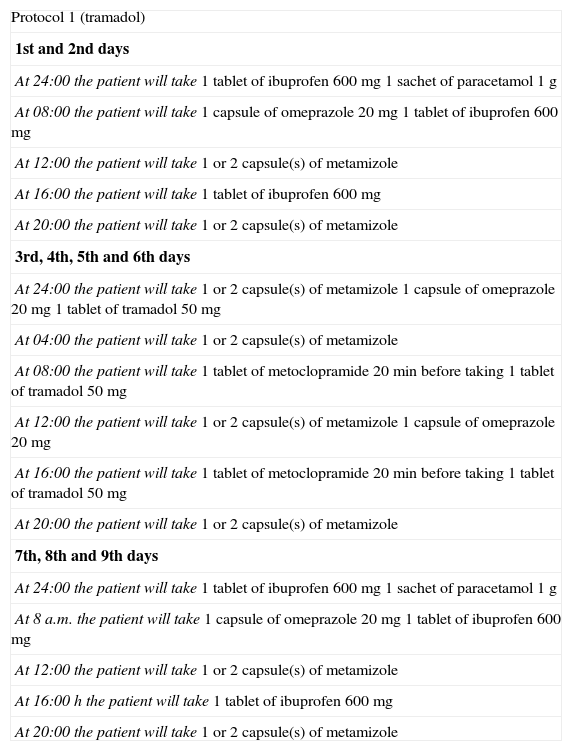Tonsillectomy causes a moderate to severe postoperative pain, and its treatment is an unsolved problem.
The objective of this study was to compare the effectiveness of two analgesic protocols and their related complications.
MethodsTwo groups of adult patients submitted to ambulatory tonsillectomy were studied. In Group 1, 52 patients received a combination of tramadol and NSAIDs postoperatively; in Group 2, 60 patients were treated with prednisone and NSAIDs. Two surgical techniques were used: cold dissection or dissection with electrocautery. Pain was recorded on days 4, 7 and 15, using a numerical scale from 0 to 10.
ResultsBoth groups showed similar pain at postoperative day 4. At day 7, pain was higher in Group 2 (P=.049), while at day 15 both groups showed only some discomfort. Sickness and vomiting was more frequent in Group 1, and haemorrhage and hospitalisation in Group 2. Cold dissection patients showed lower levels of pain at days 4 and 7, independently of analgesic protocol, and had lower haemorrhage and emergency visit rates.
ConclusionsThe efficacy of both protocols was similar in terms of control of pain, with the exception of day 7; however, the protocol with prednisone showed fewer secondary effects. Patients operated using cold dissection had less pain and fewer complications.
La amigdalectomía está incluida en los procedimientos quirúrgicos que producen dolor postoperatorio moderado-severo, y el control del mismo es un problema aun no resuelto.
El objetivo de este estudio es comparar la efectividad de 2 protocolos analgésicos y evaluar la frecuencia de complicaciones relacionadas con el tratamiento en ambos grupos.
MétodosSe realizó un estudio en 2 grupos de pacientes adultos sometidos a amigdalectomía en régimen ambulatorio. El grupo 1 incluyó 52 pacientes a los cuales se trató con una combinación de tramadol y AINE, y el grupo 2 incluyó 60 pacientes tratados con prednisona y AINE. Se emplearon 2 técnicas quirúrgicas diferentes, la disección fría o la disección con electrobisturí. La valoración del dolor se realizó utilizando una escala numérica de 0 a 10 al 4.°, 7.° y 15.° día del postoperatorio.
ResultadosAl 4.° día ambos grupos presentan puntuación media de dolor similar. Los pacientes del grupo 2 presentaron más dolor al 7.° día (p=0.049). Al 15.° día solo había pequeñas molestias en ambos grupos. Los vómitos y mareos fueron más frecuentes en el grupo 1, y los ingresos hospitalarios y las hemorragias lo fueron en el grupo 2. Los pacientes intervenidos con disección fría tuvieron menos dolor al 4.° y 7.° día, independientemente del protocolo analgésico, y presentaron menos hemorragias y visitas a urgencias.
ConclusiónLa efectividad analgésica es similar para ambos protocolos, excepto al 7.° día, aunque con menos efectos secundarios en el protocolo con prednisona. Los pacientes intervenidos con disección fría presentaron menos dolor y complicaciones que los intervenidos con electrobisturí.





